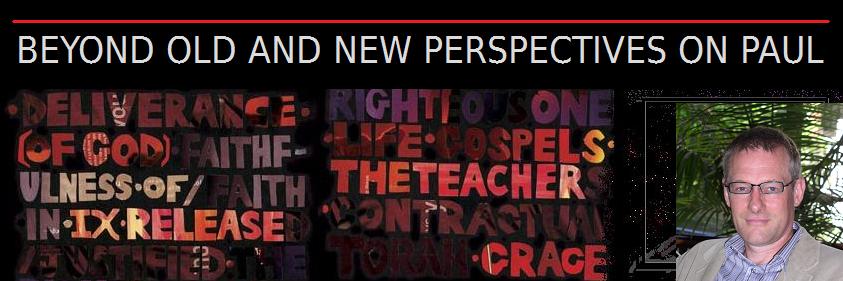
It is a real pleasure to post today's guest book review. David Moffitt and his family are good friends of ours. He is Assistant Professor of New Testament and Greek at
Campbell University Divinity School, and is one of the most exciting and gifted young NT scholars in the world.
This review (which uses the SPIonic font set) of David Moffitt's first book, is written by Dr David Allen, Director of Studies and Tutor in New Testament Studies at The Queen's Foundation, Birmingham.
My thanks to
Brill for a review copy! You can purchase a copy from Amazon
here.
David M. Moffitt, Atonement and the Logic of Resurrection in the Epistle to the Hebrews, Supplements to Novum Testamentum 14. Leiden: Brill, 2011.
One of the challenges of teaching any module – biblical studies or otherwise – is staying abreast of developments within the subject area, particularly when such developments question fundamental givens or assumptions within the discipline. One suspects that, in the light of David Moffitt’s work, many Hebrews lecturers will be reviewing their curriculum content, and (for this reviewer at least) rewriting essay questions relating to the epistle’s (lack of) interest in the resurrection. The book is a minimal revision of Moffitt’s doctoral thesis, submitted at Duke University under the supervision of Richard Hays, and it challenges a core “given” of Hebrews scholarship, namely that Hebrews has minimal interest in the resurrection when compared to its enthusiasm for the events that respectively precede and succeed it – the crucifixion and exaltation. Moffitt turns this assumption on its head, proposing instead that the resurrection is central to Hebrews’ concerns and comprises the very heart of its view of the high-priestly atonement. It is a pleasure to have the opportunity to review the work, and to grapple with the new ideas expressed within its pages.
The text breaks up into four chapters, along with a short conclusion that restates the theses established along the way. Moffitt’s first chapter surveys the status quaestionis, laying out scholarly assessments of the function of the resurrection within the epistle. Whilst he distinguishes essentially three views (the “passed over” option; the agnostic view and the “no resurrection” position) and therefore “many explanations” for Hebrews’ (apparent) silence on the resurrection, he ventures that all commentators essentially concur with the assumption that Hebrews has no use for it. In sum, the scholarly consensus assumes as follows: “the atoning significance of Jesus’ death and heavenly exaltation does not require him [i.e. Hebrews] to engage in any reflection on that event [i.e. the resurrection]” (41). The rest of the book challenges this assumption, through a tripartite argument outworked in the next three chapters.
First, Moffitt considers the role of Heb 1-2, contending that the angel-human comparison is, seminally, a comparison of essence – Jesus is greater than angels because he is human, a royal Son or second Adam, whose heavenly entry/exaltation is in human form, “the first human being to regain all the glory Adam lost” (142); the Son is a ministering a!nqrwpoj, rather than any disembodied sacerdotal pneu~ma, and is it precisely his humanity/flesh that justifies his heavenly status – he needs to be human. Tracing other “world to come” texts, Moffitt concludes that they do not espouse a flesh/spirit dualism, but rather may be viewed as constituting a renewed creation; as such he proposes that the entry of the Son into heaven (cf. the oi0koume/nh of 1:6) is the patterned on the entry of Israel into the promised land (a view I have advocated in my own work on the epistle). His argument appeals to Hebrews’ use of LXX Pss 92, 95 and 96 in support of this, but I am not convinced that that is ultimately necessary, as the Deuteronomic backdrop of Hebrews is sufficient to suggest the liminal “entry into the land” backdrop. As an aside, Moffitt suggests that, in my own work, I “fail to grasp adequately that the emphasis in Hebrews is more on a ‘New Conquest’ … than on the wandering state of the people at Kadesh Barnea” (80n80). Pedantically perhaps (!), because Moffitt and myself are essentially in agreement on the Old Testament imagery at play here, I might quote myself at this point, to the effect that “eisodus, rather than exodus, is actually the core motif for Hebrews.”
Having established Hebrews’ anthropological interests, Moffitt then turns to a survey of contemporary ascension texts (such a 1 or 2 Enoch), affirming that such heavenly journeys are enacted by fully embodied figures; coupled with this, he considers several parts of the epistle (5:7, 6:1-2, 11:17-19, 11:35) that, for Moffitt at least, seem to declare Hebrews’ interest in the resurrection. This is probably the meatiest part of the book in terms of work on Hebrews itself, and Moffitt argues that (actually) Hebrews has much to say about Jesus’ resurrection; why, for example, would 11:35 talk about a better resurrection if that is not a core part of Hebrews’ understanding? Coupled with this, he offers a reading of Hebrews 5-7 in which he revisits Hebrews’ understanding of perfection (especially 5:9), venturing that being made perfect is not a completion of his cruciform work, but rather bespeaks the capacity to enter into the heavenly realm as a living (i.e. resurrected) high-priest. For Hebrews, Jesus enters heaven as a living human, now perfected such that he might be the eternal (or, perhaps more appropriately “ever-living” – (213)) high priest.
In the final section, Moffitt takes up the third strand of his argument, namely how the resurrected, human Jesus relates to Hebrews’ atonement theology and specifically to Hebrews’ appropriation of Yom Kippur imagery. This would be familiar terrain one might think, but that is not the case, at least not in Moffitt’s presentation of it. Building on the work of amongst others, Milgrom and Sklar (and his discussion of such scholarship is fruitful for other Neutestamentler as yet unversed in such Hebrew Bible research), Moffitt affirms that blood presented in sacrifice encapsulates life, rather than death, and Heaven – and not earth – is therefore the location of Jesus’ sacrificial offering. Jesus presents his blood in the (heavenly) Holy of Holies post-resurrection, and the very “living-ness” of the offering actually enables the atoning act to have effect. Thus, rather than being peripheral or negated by the epistle, the resurrection “holds a central place in the explanation of Jesus’ atoning work in Hebrews” (296).
How might one respond to such a provocative thesis, particularly one that challenges such a core assumption about the epistle’s atonement theology? It is probably worth making two, perhaps contradictory, points at the outset. First, this is the sort of the text that needs revisiting and re-reading. Because Moffitt has marshalled such an impressive array of material, because his argument is so well framed, it can be difficult at times to stay the pace with him, especially on some of the detail of his arguments and the comprehensive footnotes. The discussion of Hebrews’ use of Ps 40, for example, is a complex discussion in its own right, and one cannot do justice to it in a short review of this type. At the same time, in terms of structure, Moffitt regularly restates his theses, with helpful concluding sections that summarize the argument thus far. The text remains a highly readable one and Moffitt gives regular summaries of his findings. At a high level, one can follow the flow of his argument/discussion with relative ease.
But what of the broader concerns of the piece? In short, Moffitt’s proposal is broadly persuasive, and makes good sense of the difficulties/puzzles that more traditional assessments come up against in terms of the consistency of Hebrews’ atonement theory. It offers a fresh perspective on the epistle, and gives solid meat to those (like myself) who wish to resist overly Platonic or Philonic readings of the letter. The discussion of the letter’s use of Ps 40 is insightful (and will warrant multiple readings) and the suggestion that Heb 1-2 comprises a spirit-human comparison of essence causes me to re-evaluate my own thinking on that pericope. On a more critical note, bearing in mind the discussion of Enochic material in relation to heavenly ascent, it was surprising that 11:5 receives little, if any, attention (if only to rule it out of the inquiry). More significantly, perhaps, the engagement with Hebrews’ appropriation of Melchizedeck terminology seems a little underdeveloped; whilst Moffitt’s discussion of 7:16 and the concept of the “indestructible life” makes good sense the phrase, I was not entirely convinced by some of the analysis. It depends upon, for example, a clear distinction between Melchizedeck being an i9ereu&j and not an a)rxiereu&j, a difference which Hebrews 7:20-28 doesn’t seem to draw that acutely, apparently moving between the two terms with some ease. I would also want to draw Moffitt out on a couple of other points. Presumably, “time would fail” him to unpack the significance for Hebrews of the resurrection for followers of Jesus; he has some hints as to how the epistle sees the “perfected spirits” of 12:23 (or even the faithful of ch.11) being impacted by the resurrection – are they “perfected” in the same way? – but some further discussion would be good and probably warrants a follow up volume! Likewise, I would also want to explore further with him the degree to which 1:2 supports his thesis; my initial supposition is that ai0w~naj (normally translated as “worlds”, but better rendered as “ages”) endorses his desire to reduce the material/spirit eschatological dichotomy within the epistle.
In sum, the book is a significant – and brave – achievement, and one looks forward to other Hebrews’ scholars engaging with it. And perhaps their having to change their essay titles accordingly….
Labels: Book Review, Guest Post
 It is at this time of the year that I wish I didn't find some poetry so ponsy. Clever people are putting sonnets on their blogs, and I am left with an Evil Santa Competition.
It is at this time of the year that I wish I didn't find some poetry so ponsy. Clever people are putting sonnets on their blogs, and I am left with an Evil Santa Competition.









